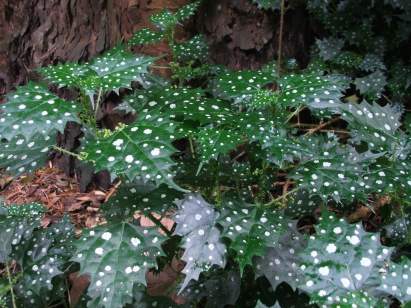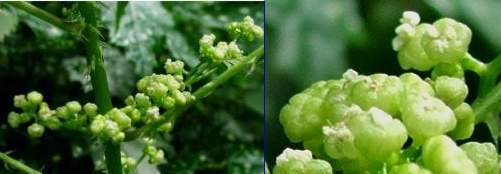Laportea grossa
Laportea grossa (Wedd.) Chew
Family: Urticaceae
Common names: spotted nettle (Eng.); gevlekte brandnetel (Afr.); ubazi, ububasa (Xhosa); imbabazane, imbathi (Zulu)
Introduction
Laportea grossa has decorative, glossy dark green foliage with conspicuous white spots - an excellent plant to brighten up a shady bed, but it needs careful handling as the plant is covered in stinging hairs.

Description
Description
Laportea grossa is a herbaceous perennial or annual, up to 1 m tall, with soft, upright stems armed with downward-pointing stinging hairs. It has a sprawling, spreading growth habit, with stems rooting at the nodes. Leaves are alternate, triangular and coarsely toothed, and are also armed with stinging hairs. Most plants, like the selection grown at Kirstenbosch, have conspicuous white spots on the leaves, but not all wild individuals boast spotted leaves. There is a stinging hair in the centre of each white spot, and there are stinging hairs on the lower surface of the leaves, particularly along the three main veins, as well as near the petiole and on the petiole. The stinging hairs of Laportea grossa are mounted on long, slender protuberances-a characterstic that the other two southern African species do not share. The pain inflicted by the spotted nettle is a sharp, burning sting that lasts a while and can cause temporary redness on the skin.

Laportea grossa is monoecious, meaning that there are male flowers and female flowers, separate from each other, but both the male and female occur on the same plant. The flowers are in panicles (branched inflorescences) in the axils of the leaves. Small and greenish, they are not decorative but are noticeable. Flowering time is midsummer to autumn (Dec.-Mar.).
The male flowers are more rounded, paler yellowish green and more noticeable than the female flowers, which are narrower and greener. The male flower is 2 mm in diameter, regular in shape, with 4 or 5 equal tepals and 5 white puffy stamens that stick out when ripe.

The female flower is 1.5 mm long, with 4 unequal tepals, one pair of tepals is much larger than the other one, and the tepals of the smaller pair are of unequal size. A white style can be seen protruding from the female flowers. Each female flower produces a single, small, dry, thin-coated seed, ± 1.7 mm long that is shed with the tepals still attached.

Conservation Status
Status
Laportea grossa is not threatened.
Distribution and habitat
Distribution description
Laportea grossa grows in moist, shady places in coastal forest, forest, closed woodland and near streams from George in the Western Cape, through the Eastern Cape, KwaZulu-Natal and Mpumalanga as far north as Kenya.
Derivation of name and historical aspects
History
The genus Laportea is named after an unidentified person called Laporte, possibly a companion of Gaudichaud on the voyage of the corvette L'Uranie in 1817-1820. The species name grossa means large. Laportea belongs in the nettle family (Urticaceae) and consists of ± 50 species, spread throughout the tropical regions of the world and extending into the temperate regions of North America and East Asia.
There are three species in southern Africa, the other two being L. alatipes (nettle) and L. peduncularis (river nettle). All three were formerly classified as Fleurya. The nettle best known to most people is the stinging nettle Urtica dioica, native to Europe but now distributed throughout the temperate areas of the world.
Ecology
Ecology
Nettles are thought to sting to defend themselves against grazing animals. Nevertheless, some animals do graze on nettles without any ill effects because they have developed resistance to the sting. In general, a stung animal will move away from where it was stung so as not to get stung again. The stinging thus also benefits the plants by keeping animals off and preventing trampling, allowing them to grow unhindered.
A nettle sting contains a hollow hair stiffened with silica and the chemicals that cause the sting are in the swollen base of the hair. When the hair is touched, the brittle tip breaks, exposing a sharp point that penetrates the skin and injects the toxin. The toxin in the stinging nettle Urtica dioica was believed to be formic acid but is now thought to consist of a histamine, acetylcholine and serotonin.
Uses
Use
The spotted nettle has been used to punish boys, and to produce sexual irritation in cattle. The young tips are cooked and eaten as a vegetable.
Its use as a deterrent of human traffic is probably not as effective as a thorny shrub such as Carissa macrocarpa or Dovyalis caffra whose thorns are both conspicuous and sharp. At Kirstenbosch I've noticed that people are drawn to the spotted nettle's interesting foliage and get an irresistible urge to touch without realising that it is a nettle, at which point its stinging hairs would come as a nasty surprise-should they not notice the warning sign or a member staff not happen to be there to warn them.

Growing Laportea grossa
Grow
Laportea grossa is a plant of the forest floor and needs full to light shade or dappled shade, well-drained, fertile, well-composted soil and lots of water, particularly during the summer months. Gardeners in the winter rainfall areas will have to feed and water this plant in summer for it to perform at its best. Grow it in a cool, well-drained but well-watered, shady area where its lovely, glossy, white-spotted foliage will stand out. Choose an out-of-the-way position where it is unlikely to be encountered-unless you wish to try and exploit its repellent characteristics. Although it is also suitable to be grown in a container on a shady patio or courtyard, or indoors, its stinging stems and leaves make it an unfriendly house guest.
Laportea grossa is not a popular plant to propagate. Nevertheless it is not that difficult to work with it and not get stung. Use thick gardening gloves, or washing up gloves, or the new generation gardening gloves that combine latex and cloth. Experienced propagators know the knack of dealing with these unfriendly plants-take hold of the stem firmly and quickly, crushing the stinging hairs before they can penetrate the skin. It is the slower, more hesitant approach that results in stung fingers.
Laportea grossa is very easy to propagate from cuttings. Take stem cuttings (all growth is soft) at any time of the year, treat with a rooting hormone for herbaceous material and place in the mist unit. The cuttings root in ± 2 weeks. It is trickier to grow them on in the nursery because it is difficult to find a spot that suits them. They need to be cool, get no direct sun and be moist but not wet. Use a well-drained soil medium-it must drain freely-and water them frequently but make sure that the soil is not soggy or waterlogged.
Because cuttings are so easy, it has not been propagated from seed at Kirstenbosch. Seed should be sown as soon as it is ripe, in a well-drained soil medium, covered lightly, and kept moist and cool.
References
- Friis, I. & Immelman, K.L. 2001. Urticaceae. Flora of southern Africa 9. National Botanical Institute, Pretoria.
- Goldblatt, P. & Manning, J. 2000. Cape plants. A conspectus of the Cape flora of South Africa. National Botanical Institute, Pretoria & Missouri Botanical Garden, Missouri.
- Hutchings, A. 1996. Zulu medicinal plants: an inventory. University of Natal Press, Pietermaritzburg.
- Jackson, W.P.U. 1990. Origins and meanings of names of South African plant genera. University of Cape Town Printing Department.
- Leistner, O.A. (ed.). 2000. Seeds plants of southern Africa : families and genera. Strelitzia 10. National Botanical Institute, Pretoria.
- Pooley, E. 1998. A field guide to wild flowers of KwaZulu-Natal and the Eastern Region. Natal Flora Publications Trust, Durban.
- Smith, C.A. 1966. Common names of South African plants. Memoirs of the Botanical Survey of South Africa No. 35.
- Website (accessed January 2008) www.nettles.org.uk/ Be Nice to Nettles Week by Working with Wildlife
Credits
Alice Notten
Kirstenbosch National Botanical Garden
March 2008
Acknowledgements: The author thanks Trevor Adams and Cherise Viljoen for sharing their experience of propagating and growing Laportea grossa at Kirstenbosch.
Plant Attributes:
Plant Type: Bi/Annual, Perennial
SA Distribution: Eastern Cape, KwaZulu-Natal, Mpumalanga, Western Cape
Soil type: Sandy, Loam
Flowering season: Late Summer
PH:
Flower colour: Green
Aspect: Shade
Gardening skill: Challenging
Special Features:
Horticultural zones









Rate this article
Article well written and informative
Rate this plant
Is this an interesting plant?
Login to add your Comment
Back to topNot registered yet? Click here to register.